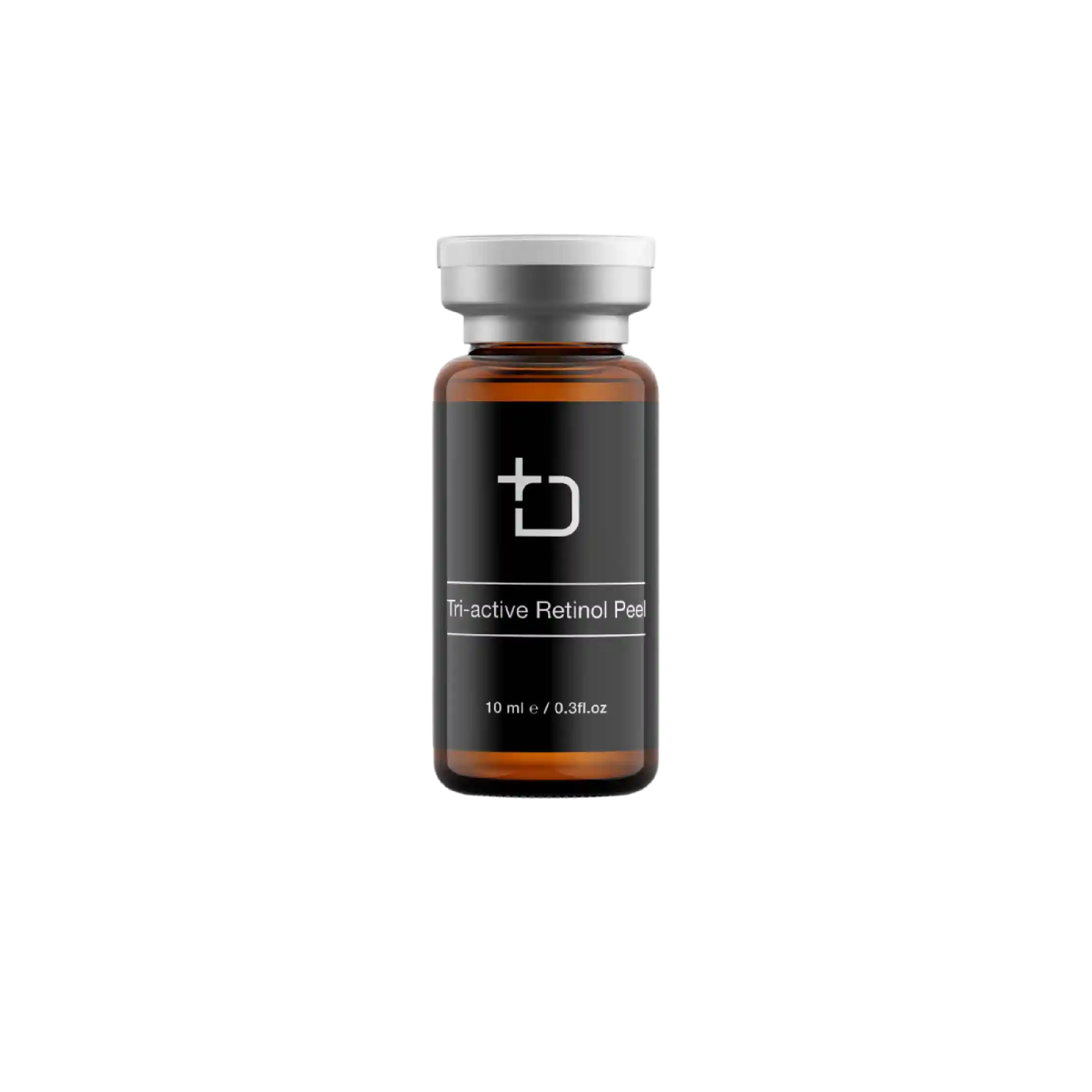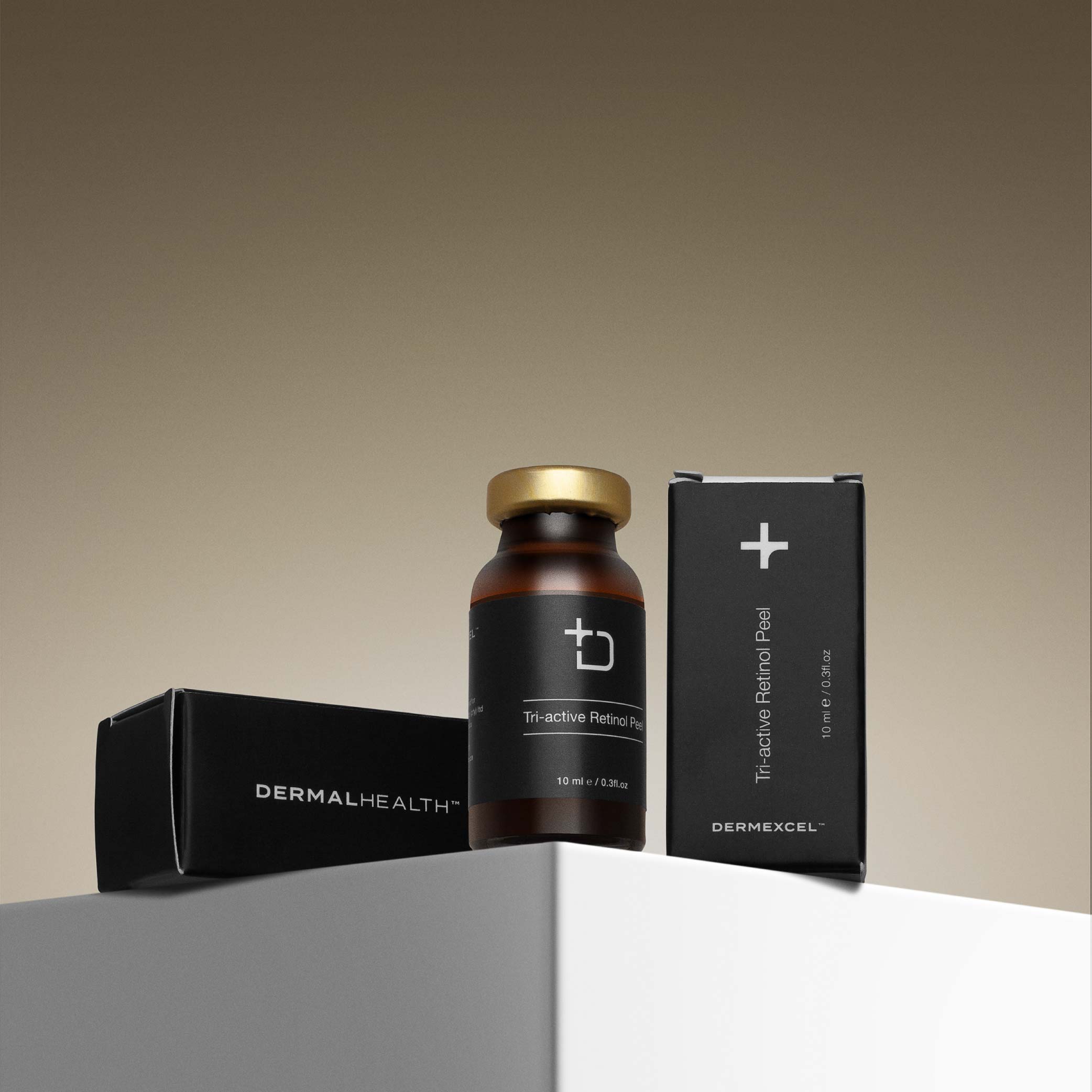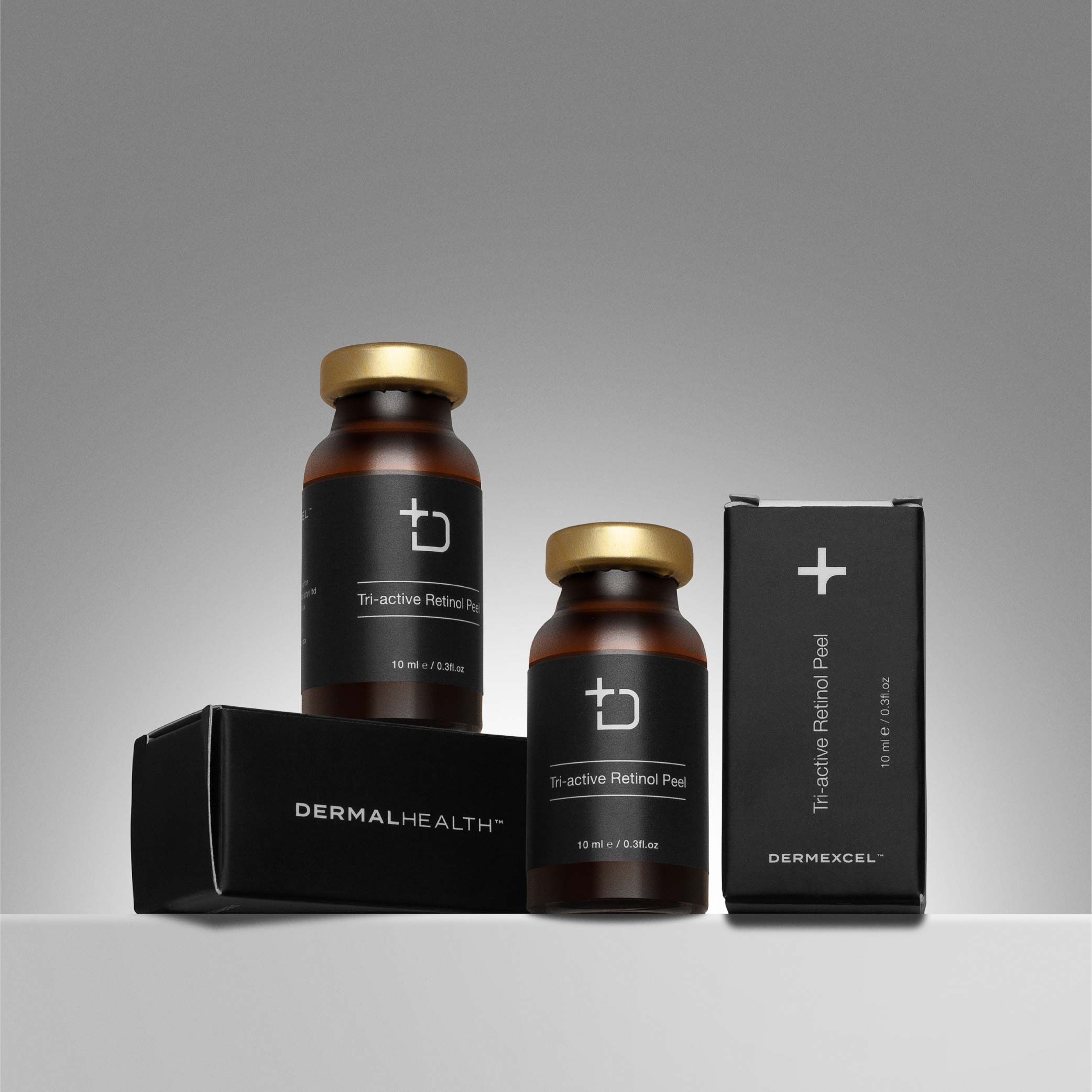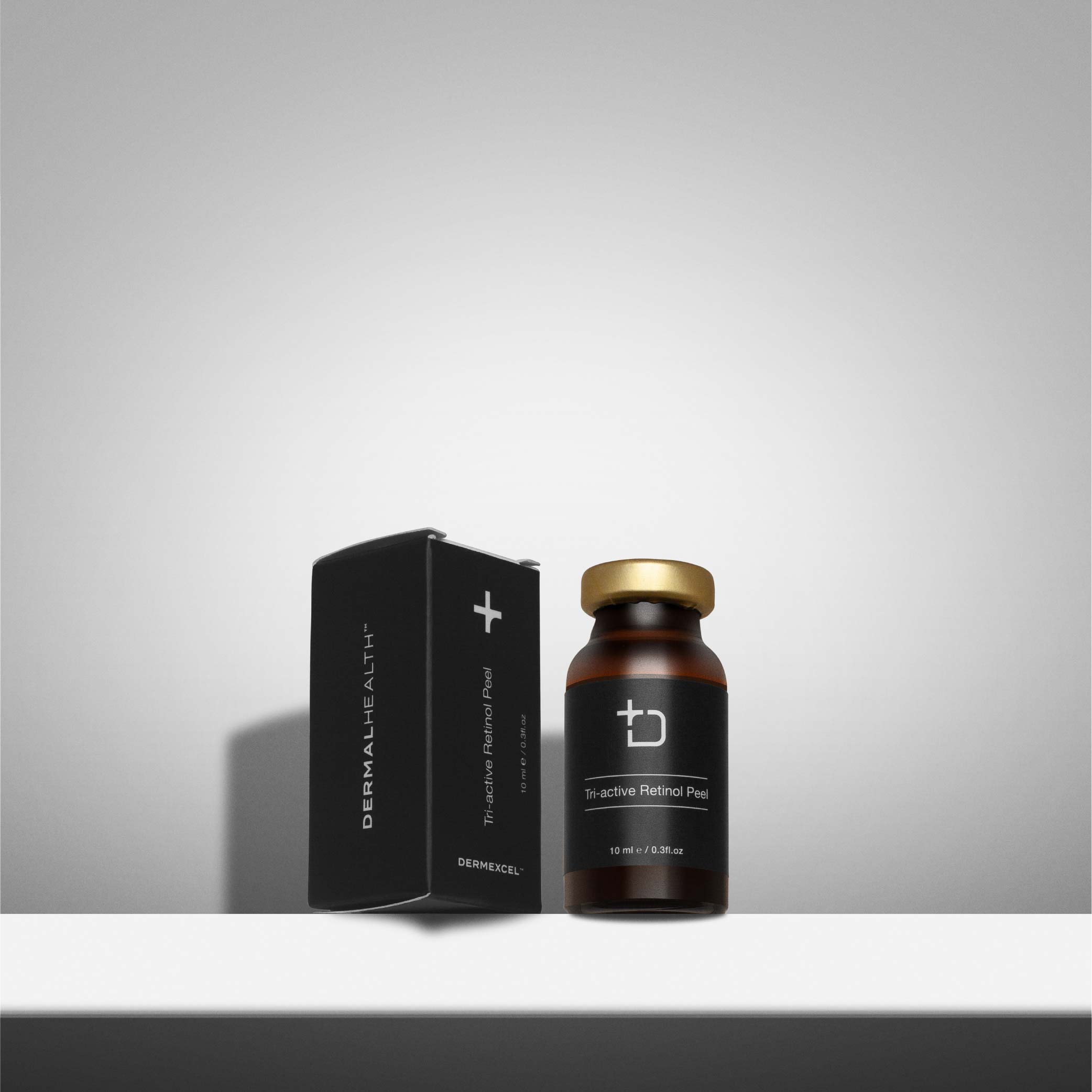








Multi-Action Retinoid Complex
Please login to view the price
loginSIZE: 10 mL

↓ pigmentation

anti-aging

↓ inflammation

↑ Collagen

Brightening
Superficial peel with depigmentation, brightening, and rejuvenating actions.
An advanced physician-strength peel that contains a high potency retinol. With a pH of 5, it combines potent retinol with the exclusive, patented ingredient Hydroxypinacolone Retinoate (Retinoic acid analogue) to greatly enhance collagen and dermal matrix production and to provide keratolytic and comedolytic action.
Tri-Active Retinol peel is designed to increase cellular turnover and improve the appearance of fine lines and wrinkles. It will help reduce acne and congested pores while promoting a bright, even, and clear complexion.
Tri-Active Retinol peel will effectively target post-inflammatory hyperpigmentation.
Retinol and Retinoic acid analogue combination
Retinoic acid, often referred to as tretinoin in its pharmaceutical form, is the active form of Vitamin A. It is widely recognized for its powerful effects in dermatology and skin care, particularly in treating acne and signs of skin aging.
Retinoic acid works at the cellular level to modify gene expression and affect cell growth. In treating acne, it promotes the turnover of skin cells, reducing the likelihood of pore-clogging and helping to clear existing breakouts. Additionally, it decreases the cohesiveness of follicular epithelial cells, further preventing the formation of comedones.
Retinoic acid's ability to stimulate collagen production is a key benefit in anti-aging skincare. This leads to a reduction in fine lines and wrinkles and an improvement in overall skin texture and tone. It also aids skin discoloration and hyperpigmentation by accelerating cell turnover, bringing new skin cells to the surface faster, and shedding pigmented and damaged cells.
Despite its benefits, retinoic acid can irritate the skin, causing side effects like redness, dryness, and peeling, especially during the initial period of use. Its potency means it is generally available by prescription and requires careful monitoring by a healthcare professional.
Hydroxypinacolone Retinoate (HPR) is a newer, esterified form of retinoic acid. Unlike cosmetic retinol, HPR binds directly to the retinoid receptors of the skin cells without needing conversion. This direct binding allows it to deliver similar benefits to retinoic acid, such as stimulating collagen production, improving skin elasticity, and reducing signs of aging, but with a lower risk of irritation.
HPR is considered more gentle and less irritating than traditional retinoic acid while offering comparable benefits. With HPR, everyone has access to the benefits of prescription retinoids without the risk of side effects.
Physiological Effects
- Cell Turnover and Renewal: HPR promotes rapid cell turnover, aiding in the exfoliation of dead skin cells and generating new cells.
- Skin Texture: Promoting cell renewal improves skin texture and addresses issues like roughness and dullness.
- Collagen Production: It stimulates collagen production, which is essential for reducing the appearance of fine lines and wrinkles and improving skin elasticity.
- Acne Treatment: Effective in treating acne by unclogging pores and reducing the size of sebaceous glands, it diminishes both inflammatory and non-inflammatory acne lesions.
- Pigmentation: It can reduce hyperpigmentation by accelerating the turnover of hyperpigmented skin cells and inhibiting melanin production.
- Photoaging: Effective in treating signs of photoaging, reversing some of the damage caused by UV radiation.
Special Benefits
- Retinoid Receptor Activity: HPR, an ester of retinoic acid, binds directly to retinoid receptors in the skin, enabling it to work without needing to be converted into retinoic acid.
- Lower Irritation: Typically, it causes less irritation than retinoic acid, making it more suitable for sensitive skin types.
- Collagen Stimulation and Anti-Aging: Like retinoic acid, HPR helps in stimulating collagen production and has anti-aging properties.
- Acne and Hyperpigmentation: It effectively treats acne and reduces hyperpigmentation, often with fewer side effects than retinoic acid.
- Stability and Penetration: HPR is more stable and lipid-soluble, so it penetrates the skin more effectively and is less prone to degradation.
References
- Zaenglein, A. L., Pathy, A. L., Schlosser, B. J., Alikhan, A., Baldwin, H. E., Berson, D. S., ... & Thiboutot, D. M. (2016). Guidelines of care for the management of acne vulgaris. Journal of the American Academy of Dermatology, 74(5), 945-973.e33.
- Fisher, G. J., Wang, Z. Q., Datta, S. C., Varani, J., Kang, S., & Voorhees, J. J. (1996). Pathophysiology of premature skin aging induced by ultraviolet light. New England Journal of Medicine, 337(20), 1419-1428.
- Truchuelo, M. T., Jiménez, N., Jaén, P. (2018). Assessment of the efficacy of a new complex-based retinoic acid and retinol in a 3-month study using objective methods and skin biomarker analysis. Journal of Cosmetic Dermatology, 17(3), 347-354.
- Mukherjee, S., et al. (2006). Retinoids in the treatment of skin aging: an overview of clinical efficacy and safety. Clinical Interventions in Aging.
- Randhawa, M., et al. (2015). Hydroxypinacolone retinoate: a new retinoid and its use in dermatology. Skin Therapy Letter.




SHIPPING
- Shipping Guarantee: Guiding you to healthy skin isn’t only about our products; it's also about getting them to you as swiftly as the science behind them. That's why Dermal Health offers a shipping guarantee you can rely on.
- Where We Ship From: Orders are dispatched from our facilities in Pretoria.
- Who We Ship With: We trust only well-known, popular, and dependable courier services with your packages.
- When You'll Get It: Expect confident skin soon! Shipping addresses in Pretoria and Johannesburg will enjoy delivery from same-day to 2 business days. Shipping addresses further from Pretoria may expect delivery within 1-4 business days, depending on the service you select during checkout. Your estimated delivery date will reflect during checkout so that you can mark your calendar.
- Tracking Your Order: Eager to start your DermExcel journey? We don't blame you! You'll receive a tracking number after you place your order so that you can follow your package.
For any shipping inquiries, our customer service team is ready to assist.
RETURNS
180-Day Satisfaction Guarantee
Want to log a return? We’ve got you.
You’re welcome to return any product within 180 days of purchase—even if it’s not defective—as long as it’s sealed, unused, in its original packaging, and still within six months of its labeled expiration date (located on the bottom of the product). We get it: sometimes things change.
For non-defective returns, courier costs will be your responsibility.
If you believe a product is defective, please provide a brief explanation so our team can properly assess and process your claim.
Just complete our quick Return Form and we’ll take it from there.
Healthy Skin Isn’t Complicated. Neither Is Our Return Policy.
Visit our Return Policy page or contact our friendly support team if you need assistance.
SECURE PAYMENT
Dermal Health Science 30-Day Confidence Guarantee: We are passionate about guiding you to healthy skin through medical science. We believe in the quality and effectiveness of our products so much that we offer a 30-Day Confidence Guarantee. If you're unsatisfied with your purchase, simply return it within 30 days for a full refund.
Healthy Skin Is Not Complicated and neither is our return policy. Please visit our detailed return policy or contact our friendly customer service team for more information.
Feel as confident in us as we want you to feel in your skin.
- Aging Related Conditions: Stimulates collagen production, improving skin elasticity and reducing the appearance of fine lines and wrinkles.
- Photodamage: Repairs sun-damaged skin by improving texture, tone, and reducing sunspots.
- Hyperpigmentation: Fades dark spots, melasma, and post-inflammatory hyperpigmentation for a more even skin tone.
- Acne and Acne Scarring: Reduces active acne, prevents future breakouts, and improves the appearance of post-acne scars.
- Inflammation: Helps to calm existing breakouts and reduce redness associated with inflammatory acne.
- Dull and Lifeless skin: Promotes cell turnover, smoothing rough skin and brightening dull complexions.
- Actinic Keratosis: Aids in the reduction of rough, precancerous sun-damaged patches, though medical supervision is recommended.
- Cleanse the skin with Pore Control Cleanser.
- Use the Pre-Peel Solution to remove excess oil from the skin.
- Apply 1-2ml peel solution with cotton buds or brush.
- Leave the solution on the skin.
- Do not rinse or neutralize. The peel solution is left on the patient and rinsed off at home after 4-8 hours of contact time.
- After rinsing off the peel, cleanse with Pore Control Cleanser or Medi-Zinc Cleanser
- Apply any DermExcel Moisturizer.
- Resume all active ingredients after post-peel irritation subsides.
Active ingredients
- Cell Turnover and Renewal: HPR promotes rapid cell turnover, aiding in the exfoliation of dead skin cells and generating new cells.
- Skin Texture: Promoting cell renewal improves skin texture and addresses issues like roughness and dullness.
- Collagen Production: It stimulates collagen production, which is essential for reducing the appearance of fine lines and wrinkles and improving skin elasticity.
- Acne Treatment: Effective in treating acne by unclogging pores and reducing the size of sebaceous glands, it diminishes both inflammatory and non-inflammatory acne lesions.
- Pigmentation: It can reduce hyperpigmentation by accelerating the turnover of hyperpigmented skin cells and inhibiting melanin production.
- Photoaging: Effective in treating signs of photoaging, reversing some of the damage caused by UV radiation.
- Retinoid Receptor Activity: HPR, an ester of retinoic acid, binds directly to retinoid receptors in the skin, enabling it to work without needing to be converted into retinoic acid.
- Lower Irritation: Typically, it causes less irritation than retinoic acid, making it more suitable for sensitive skin types.
- Collagen Stimulation and Anti-Aging: Like retinoic acid, HPR helps in stimulating collagen production and has anti-aging properties.
- Acne and Hyperpigmentation: It effectively treats acne and reduces hyperpigmentation, often with fewer side effects than retinoic acid.
- Stability and Penetration: HPR is more stable and lipid-soluble, so it penetrates the skin more effectively and is less prone to degradation.
- Zaenglein, A. L., Pathy, A. L., Schlosser, B. J., Alikhan, A., Baldwin, H. E., Berson, D. S., ... & Thiboutot, D. M. (2016). Guidelines of care for the management of acne vulgaris. Journal of the American Academy of Dermatology, 74(5), 945-973.e33.
- Fisher, G. J., Wang, Z. Q., Datta, S. C., Varani, J., Kang, S., & Voorhees, J. J. (1996). Pathophysiology of premature skin aging induced by ultraviolet light. New England Journal of Medicine, 337(20), 1419-1428.
- Truchuelo, M. T., Jiménez, N., Jaén, P. (2018). Assessment of the efficacy of a new complex-based retinoic acid and retinol in a 3-month study using objective methods and skin biomarker analysis. Journal of Cosmetic Dermatology, 17(3), 347-354.
- Mukherjee, S., et al. (2006). Retinoids in the treatment of skin aging: an overview of clinical efficacy and safety. Clinical Interventions in Aging.
- Randhawa, M., et al. (2015). Hydroxypinacolone retinoate: a new retinoid and its use in dermatology. Skin Therapy Letter.
Retinol and Retinoic acid analogue combination
Retinoic acid, often referred to as tretinoin in its pharmaceutical form, is the active form of Vitamin A. It is widely recognized for its powerful effects in dermatology and skin care, particularly in treating acne and signs of skin aging.
Retinoic acid works at the cellular level to modify gene expression and affect cell growth. In treating acne, it promotes the turnover of skin cells, reducing the likelihood of pore-clogging and helping to clear existing breakouts. Additionally, it decreases the cohesiveness of follicular epithelial cells, further preventing the formation of comedones.
Retinoic acid's ability to stimulate collagen production is a key benefit in anti-aging skincare. This leads to a reduction in fine lines and wrinkles and an improvement in overall skin texture and tone. It also aids skin discoloration and hyperpigmentation by accelerating cell turnover, bringing new skin cells to the surface faster, and shedding pigmented and damaged cells.
Despite its benefits, retinoic acid can irritate the skin, causing side effects like redness, dryness, and peeling, especially during the initial period of use. Its potency means it is generally available by prescription and requires careful monitoring by a healthcare professional.
Hydroxypinacolone Retinoate (HPR) is a newer, esterified form of retinoic acid. Unlike cosmetic retinol, HPR binds directly to the retinoid receptors of the skin cells without needing conversion. This direct binding allows it to deliver similar benefits to retinoic acid, such as stimulating collagen production, improving skin elasticity, and reducing signs of aging, but with a lower risk of irritation.
HPR is considered more gentle and less irritating than traditional retinoic acid while offering comparable benefits. With HPR, everyone has access to the benefits of prescription retinoids without the risk of side effects.
Physiological Effects
Special Benefits
References
Full Ingredient list
11.5% Retinol and Retinoic acid analogue combination
Tri-Active Retinol Peel
mode of action
Pigmentation Treatment
- Retinoids disrupt melanin synthesis and distribution within the skin. By increasing cell turnover, they promote the shedding of melanin-laden keratinocytes, leading to gradual lightening of hyperpigmented areas.
- Retinoic acid analogues also act at the cellular level to inhibit tyrosinase, an enzyme critical to melanin production, which helps prevent new pigment formation.
- Reduction in Hyperpigmentation: Faster exfoliation of pigmented cells and tyrosinase inhibition help fade dark spots and prevent new ones from forming.
- Even Skin Tone: Consistent cell renewal and pigment inhibition promote a more uniform complexion over time.
Anti-aging
- Retinol and retinoic acid analogues work by accelerating cell turnover and stimulating collagen production in the dermal layers. This process smooths fine lines and wrinkles, enhances elasticity, and thickens the skin, making it more resilient.
- By encouraging the replacement of older cells with newer ones, these ingredients also improve skin texture and firmness, which diminishes the visible signs of aging.
- Fine Lines and Wrinkles: Increased collagen synthesis reduces the depth of fine lines and wrinkles.
- Skin Elasticity: Stimulated fibroblasts improve skin elasticity, resulting in a firmer, more youthful appearance.
Anti-Acne & Unclog Pores
- Retinoids help to unclog pores by increasing cell turnover and preventing dead cells from accumulating and blocking follicles.
- This reduces acne formation, particularly comedonal acne, by preventing pore congestion.
- By preventing the buildup of dead cells within hair follicles, retinoids help to keep pores clear, reducing the likelihood of comedones (whiteheads and blackheads) and other types of acne.
Anti-Inflammation
- Although retinoids are powerful exfoliants, they also have anti-inflammatory effects, particularly useful for reducing mild to moderate inflammation in the skin.
- Retinoic acid analogues normalize the skin’s response to external stressors and reduce cytokine activity, which minimizes the inflammatory process and helps keep the skin calm. This is beneficial for inflammatory conditions, as well as redness caused by conditions like acne.
- Reduced Redness and Irritation: The anti-inflammatory properties of retinoids help calm the skin, making it less reactive and reducing visible redness.
- Balanced Skin Barrier: By regulating skin response and exfoliation, retinoids help reduce inflammatory triggers and maintain a more resilient skin barrier.
Actinic Damage Repair
- This retinoid combination promotes rapid exfoliation and renewal of damaged skin cells, reducing the rough, scaly patches characteristic of Actinic Keratosis.
- Additionally, Retinoic acid analogues have been shown to normalize keratinocyte behaviour, reducing atypical cell formation that leads to Actinic Keratosis.
- Smoother Texture: Accelerated cell turnover helps remove rough patches and reduce the appearance of precancerous lesions.
- Reduction of Atypical Cells: By normalizing keratinocyte function, retinoids lower the chance of actinic keratosis progressing into more serious skin issues.
Photodamage Repair
- Photodamage often presents as rough texture, lines, and uneven pigmentation. Retinol and Retinoic acid analogues target these issues by boosting collagen and elastin production and enhancing skin cell renewal.
- This action helps reverse UV-induced cellular damage by replacing damaged skin cells with healthy, newly formed cells.
- Improved Skin Texture: Faster cell turnover smooths rough, sun-damaged areas.
- Reduction of Sun-Induced Lines and Wrinkles: Enhanced collagen synthesis helps to fill in fine lines and wrinkles caused by UV exposure.
Testimonials
Perfect size for traveling or when you just need extra product.
I have been using Glycolic Gel’s for about a year every second night alternating between my other teatments and have definitely reduce skin redness and improve skin texture. It is light on the skin and I love the overall feeling of the product.
Amazing product for acne-prone skin. Leaves the skin soft and smooth. It has been a great addition to my skincare regimen whilst battling acne.
I went without it for a few months and I can feel the difference after just a week of having it as a part of my routine again!


